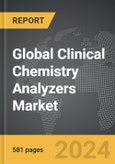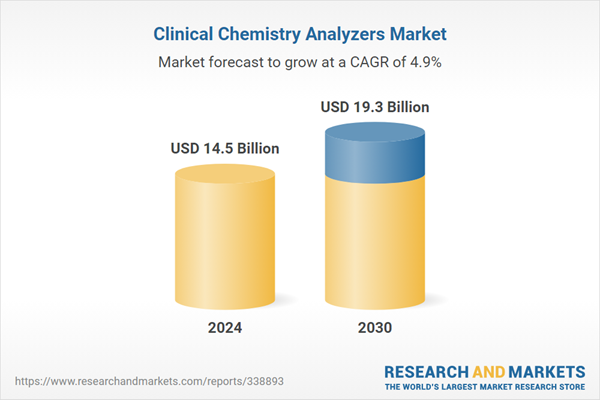The global market for Clinical Chemistry Analyzers was valued at US$14.5 Billion in 2024 and is projected to reach US$19.3 Billion by 2030, growing at a CAGR of 4.9% from 2024 to 2030. This comprehensive report provides an in-depth analysis of market trends, drivers, and forecasts, helping you make informed business decisions. The report includes the most recent global tariff developments and how they impact the Clinical Chemistry Analyzers market.
The integration of automation and information technology has significantly enhanced the capabilities of clinical chemistry analyzers. Automation reduces the potential for human error and increases throughput, allowing laboratories to handle higher volumes of tests with greater accuracy and efficiency. Additionally, the advent of high-throughput systems equipped with advanced detection technologies and software analytics has propelled the use of clinical chemistry analyzers in large-scale screening and epidemiological studies. These systems can also be integrated with laboratory information systems (LIS), enabling seamless data flow and management, which is critical for modern healthcare facilities that aim to deliver timely and precise patient care. The ongoing advancements in microfluidics and molecular diagnostics are further refining the precision and reducing the sample volumes required, which enhances the diagnostic capabilities of these analyzers.
The growth in the clinical chemistry analyzers market is driven by several factors, including the rising prevalence of chronic diseases, technological advancements, and increased healthcare spending. As global populations age and lifestyle-related diseases such as obesity, diabetes, and hypertension become more prevalent, the demand for regular and comprehensive biochemical assessments increases, thus boosting the need for clinical chemistry services. Technological advancements that offer faster, more accurate, and cost-effective analyses are particularly influential, as they improve the efficiency of clinical diagnostics and patient management. Additionally, expanding healthcare infrastructures and investments in healthcare technology in emerging economies are opening new avenues for the adoption of advanced clinical chemistry analyzers. Economic factors such as cost-containment in healthcare and the shift towards preventive care and personalized medicine also play significant roles in shaping market dynamics.
Segments: Product (Reagents, Analyzers, and Other Products); Test (Basic Metabolic Panel, Electrolyte Panel, Liver Panel, Lipid Profile, and Other Tests); End-Use (Hospitals & Clinics, Diagnostic Laboratories, Research Laboratories & Institutes, and Other End-Uses).
Geographic Regions/Countries: World; USA; Canada; Japan; China; Europe; France; Germany; Italy; UK; Spain; Russia; Rest of Europe; Asia-Pacific; Australia; India; South Korea; Rest of Asia-Pacific; Latin America; Argentina; Brazil; Mexico; Rest of Latin America; Middle East; Iran; Israel; Saudi Arabia; UAE; Rest of Middle East; Africa.
The analysts continuously track trade developments worldwide, drawing insights from leading global economists and over 200 industry and policy institutions, including think tanks, trade organizations, and national economic advisory bodies. This intelligence is integrated into forecasting models to provide timely, data-driven analysis of emerging risks and opportunities.
Global Clinical Chemistry Analyzers Market - Key Trends & Drivers Summarized
Clinical chemistry analyzers are sophisticated laboratory instruments designed to measure the concentrations of various chemical constituents within biological samples. These analyzers play a crucial role in clinical laboratories by providing essential data used in diagnosing and monitoring diseases, such as diabetes, cardiovascular ailments, and kidney disorders. The functionality of these devices ranges from simple, manual single-parameter measurements to highly automated, complex systems capable of handling multiple tests simultaneously. Modern clinical chemistry analyzers utilize various methodologies, including photometric and colorimetric testing, ion-selective potentiometry, and enzyme-linked immunosorbent assays, among others. This versatility enables comprehensive biochemical profiling from blood serum, plasma, urine, and other bodily fluids, supporting a wide array of medical investigations.The integration of automation and information technology has significantly enhanced the capabilities of clinical chemistry analyzers. Automation reduces the potential for human error and increases throughput, allowing laboratories to handle higher volumes of tests with greater accuracy and efficiency. Additionally, the advent of high-throughput systems equipped with advanced detection technologies and software analytics has propelled the use of clinical chemistry analyzers in large-scale screening and epidemiological studies. These systems can also be integrated with laboratory information systems (LIS), enabling seamless data flow and management, which is critical for modern healthcare facilities that aim to deliver timely and precise patient care. The ongoing advancements in microfluidics and molecular diagnostics are further refining the precision and reducing the sample volumes required, which enhances the diagnostic capabilities of these analyzers.
The growth in the clinical chemistry analyzers market is driven by several factors, including the rising prevalence of chronic diseases, technological advancements, and increased healthcare spending. As global populations age and lifestyle-related diseases such as obesity, diabetes, and hypertension become more prevalent, the demand for regular and comprehensive biochemical assessments increases, thus boosting the need for clinical chemistry services. Technological advancements that offer faster, more accurate, and cost-effective analyses are particularly influential, as they improve the efficiency of clinical diagnostics and patient management. Additionally, expanding healthcare infrastructures and investments in healthcare technology in emerging economies are opening new avenues for the adoption of advanced clinical chemistry analyzers. Economic factors such as cost-containment in healthcare and the shift towards preventive care and personalized medicine also play significant roles in shaping market dynamics.
Report Scope
The report analyzes the Clinical Chemistry Analyzers market, presented in terms of units. The analysis covers the key segments and geographic regions outlined below.Segments: Product (Reagents, Analyzers, and Other Products); Test (Basic Metabolic Panel, Electrolyte Panel, Liver Panel, Lipid Profile, and Other Tests); End-Use (Hospitals & Clinics, Diagnostic Laboratories, Research Laboratories & Institutes, and Other End-Uses).
Geographic Regions/Countries: World; USA; Canada; Japan; China; Europe; France; Germany; Italy; UK; Spain; Russia; Rest of Europe; Asia-Pacific; Australia; India; South Korea; Rest of Asia-Pacific; Latin America; Argentina; Brazil; Mexico; Rest of Latin America; Middle East; Iran; Israel; Saudi Arabia; UAE; Rest of Middle East; Africa.
Key Insights:
- Market Growth: Understand the significant growth trajectory of the Reagents segment, which is expected to reach US$12.5 Billion by 2030 with a CAGR of a 5.3%. The Analyzers segment is also set to grow at 4.4% CAGR over the analysis period.
- Regional Analysis: Gain insights into the U.S. market, valued at $4.9 Billion in 2024, and China, forecasted to grow at an impressive 6.4% CAGR to reach $2.1 Billion by 2030. Discover growth trends in other key regions, including Japan, Canada, Germany, and the Asia-Pacific.
Why You Should Buy This Report:
- Detailed Market Analysis: Access a thorough analysis of the Global Clinical Chemistry Analyzers Market, covering all major geographic regions and market segments.
- Competitive Insights: Get an overview of the competitive landscape, including the market presence of major players across different geographies.
- Future Trends and Drivers: Understand the key trends and drivers shaping the future of the Global Clinical Chemistry Analyzers Market.
- Actionable Insights: Benefit from actionable insights that can help you identify new revenue opportunities and make strategic business decisions.
Key Questions Answered:
- How is the Global Clinical Chemistry Analyzers Market expected to evolve by 2030?
- What are the main drivers and restraints affecting the market?
- Which market segments will grow the most over the forecast period?
- How will market shares for different regions and segments change by 2030?
- Who are the leading players in the market, and what are their prospects?
Report Features:
- Comprehensive Market Data: Independent analysis of annual sales and market forecasts in US$ Million from 2024 to 2030.
- In-Depth Regional Analysis: Detailed insights into key markets, including the U.S., China, Japan, Canada, Europe, Asia-Pacific, Latin America, Middle East, and Africa.
- Company Profiles: Coverage of players such as Agilent Technologies, Inc., Bio-Rad Laboratories, Inc., bioMerieux SA, Alfa Wassermann, Inc., Diatron MI Zrt and more.
- Complimentary Updates: Receive free report updates for one year to keep you informed of the latest market developments.
Some of the 98 companies featured in this Clinical Chemistry Analyzers market report include:
- Agilent Technologies, Inc.
- Bio-Rad Laboratories, Inc.
- bioMerieux SA
- Alfa Wassermann, Inc.
- Diatron MI Zrt
- DiaSys Diagnostic Systems GmbH
- Agappe Diagnostics Ltd.
- DIALAB GmbH
- Diconex SA
- Chengdu Seamaty Technology Co., Ltd.
- BIOBASE
- AMEDA Labordiagnostik GmbH
- DAS srl
- CPC Diagnostics Pvt Ltd.
- Abbott Diagnostics
Tariff Impact Analysis: Key Insights for 2025
Global tariff negotiations across 180+ countries are reshaping supply chains, costs, and competitiveness. This report reflects the latest developments as of April 2025 and incorporates forward-looking insights into the market outlook.The analysts continuously track trade developments worldwide, drawing insights from leading global economists and over 200 industry and policy institutions, including think tanks, trade organizations, and national economic advisory bodies. This intelligence is integrated into forecasting models to provide timely, data-driven analysis of emerging risks and opportunities.
What’s Included in This Edition:
- Tariff-adjusted market forecasts by region and segment
- Analysis of cost and supply chain implications by sourcing and trade exposure
- Strategic insights into geographic shifts
Buyers receive a free July 2025 update with:
- Finalized tariff impacts and new trade agreement effects
- Updated projections reflecting global sourcing and cost shifts
- Expanded country-specific coverage across the industry
Table of Contents
I. METHODOLOGYMII. EXECUTIVE SUMMARY2. FOCUS ON SELECT PLAYERSIII. MARKET ANALYSISCANADAITALYSPAINRUSSIAREST OF EUROPESOUTH KOREAREST OF ASIA-PACIFICARGENTINABRAZILMEXICOREST OF LATIN AMERICAIRANISRAELSAUDI ARABIAUNITED ARAB EMIRATESREST OF MIDDLE EASTIV. COMPETITION
1. MARKET OVERVIEW
3. MARKET TRENDS & DRIVERS
4. GLOBAL MARKET PERSPECTIVE
UNITED STATES
JAPAN
CHINA
EUROPE
FRANCE
GERMANY
UNITED KINGDOM
ASIA-PACIFIC
AUSTRALIA
INDIA
LATIN AMERICA
MIDDLE EAST
AFRICA
Companies Mentioned (Partial List)
A selection of companies mentioned in this report includes, but is not limited to:
- Agilent Technologies, Inc.
- Bio-Rad Laboratories, Inc.
- bioMerieux SA
- Alfa Wassermann, Inc.
- Diatron MI Zrt
- DiaSys Diagnostic Systems GmbH
- Agappe Diagnostics Ltd.
- DIALAB GmbH
- Diconex SA
- Chengdu Seamaty Technology Co., Ltd.
- BIOBASE
- AMEDA Labordiagnostik GmbH
- DAS srl
- CPC Diagnostics Pvt Ltd.
- Abbott Diagnostics
Table Information
| Report Attribute | Details |
|---|---|
| No. of Pages | 581 |
| Published | April 2025 |
| Forecast Period | 2024 - 2030 |
| Estimated Market Value ( USD | $ 14.5 Billion |
| Forecasted Market Value ( USD | $ 19.3 Billion |
| Compound Annual Growth Rate | 4.9% |
| Regions Covered | Global |









